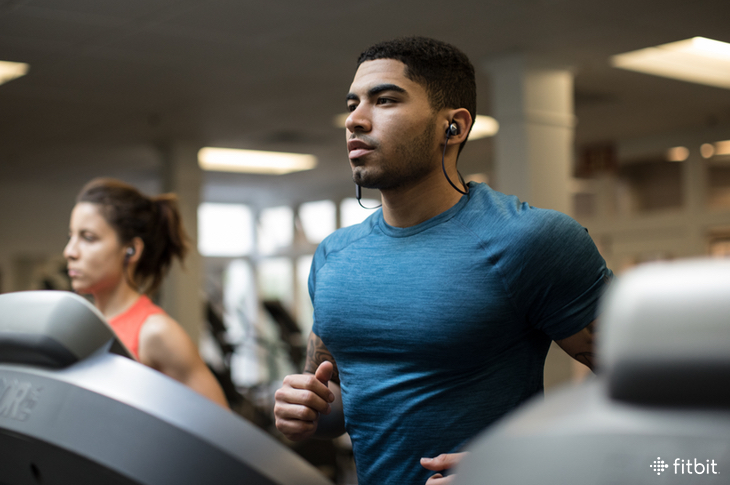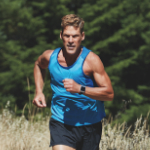
Let’s be honest, getting outside in the cold can be challenging. And with the recent extreme subzero temperatures sweeping across much of the US, it can even be dangerous. The gym is an option, but sometimes getting there can be tough. What if there were a simpler way to boost your cardio in winter?
Well, there is. If fact, you’ve probably got all the tools you need. The workout I’ve developed relies simply on body weight and a few small props you’re likely to have lying around the house (like a chair or door ledge). Whether you do it while blasting your favorite jams, watching television, or simply exercising in silence, give this workout your all. I think you’ll be pleased at the stats you see on your Fitbit device.
Dean’s Indoor Cardio Workout
Repeat this quick 15- to 20-minute workout five to six times a week (twice if you’re just starting out). As you get used to the sequence, you can swap in exercise variations as desired. For example, burpees can take the place of lunges and crunches can be swapped out for planks. Here’s an overview, followed by exercise instructions:
Begin With:
Traditional push-ups: 20 reps
Close-grip push-ups: 10 reps
Wide-grip push-ups: 10 reps
Standing push-ups: 10 reps
Transition To:
Pull-ups: 15
Transition To:
Chair dips: 50
Transition To:
Hanging leg-ups: 20 reps
Transition To:
Jumping lunges: 50 reps
Transition To:
Chin-ups: 15 reps
Transition To:
V-ups: 60 reps
Crunches 30 reps
Stationary leg crunches: 30 reps
Here’s how to execute each move:
Push-ups: The push-ups routine consists of not only traditional push-ups, but also close-grip push-ups, wide-grip push-ups, and standing push-ups. Each variation works a different part of the shoulders, triceps, and chest. I start with 20 traditional push-ups, immediately followed by 10 close-grip push-ups, 10 wide-grip push-ups, and 10 standing push-ups. For each variation, the positioning of your hands will change.
For close-grip push-ups, place your hands closer than shoulder-width apart and use your triceps and pecs to push your body back up. For wide-grip push-ups, place your hands wider than shoulder-width apart, spread your legs wider open, and feel the emphasis on your pectoral muscles. For standard push-ups, stack your shoulders over your wrists and make sure your elbows push back (not out) when lowering. When it comes to standing (or wall) push-ups, maintain standard to wide hand positioning. For these, keep one thing in mind: The further your feet are from the wall, the harder the rep.
You can scale the ratio depending on your strength, but the last few reps of each variation should feel nearly impossible. Looking for an added challenge? Take a page from my book and ease yourself back down slowly after each rep to help build concentric strength (the point at which a muscle contracts or shortens with resistance).
Pull-ups: I use a ledge in my house to perform pull-ups—which are great for strengthening your back and grip—but you can also use a pull-up bar if you have one handy. For pull-ups, choose between either a wide or medium grip. Hold onto the bar or ledge, extending both of your arms. Pull yourself up until the bar touches your upper chest. The key is to concentrate on squeezing your back muscles together. Then slowly lower and repeat for reps.
Chair dips: In one simple movement, you’ll be putting your triceps (the backs of your arms) to the test as they work to hold up the weight of your entire body. Holding onto the edge of a chair, with your knuckles facing forward, slowly lower your body as you bend your elbows. Allow your elbows to form a 90-degree angle before pushing back up. Complete as many reps as you can with proper form. Again, the most important thing is that you are struggling by the end of your last rep.
Hanging leg-ups: Grab on to the same ledge you used for pull-ups. Hanging from the ledge, draw your knees in to your chest. Focus on engaging your core and using your abs to bring your knees up. Move in a slow-and-controlled manner to prevent yourself from swinging. By using your abdominals to stabilize your body, you’ll get in some additional core work as you strengthen your hip flexors. Looking to increase the intensity? I also alternate between scissoring, or quickly alternating my feet to the left and then to the right. This really targets the lower abdominals.
Jumping lunges: This is an explosive move that is sure to rev your heart rate. I use the Fitbit Ionic to monitor heart rate—targeting a range of between 140 and 150 beats per minute—while completing a total of fifty jumping lunges. For each lunge, step forward with one leg, lowering it to a kneeling position. Allow your back knee to lower until it nearly touches the ground. Make sure your front knee does not surpass your toes, and keep your torso lifted throughout the movement. It took me a while to work up to 50 reps, so you might need to start with 10. After this movement, you should feel the burn in your glutes, quads, hamstrings, and calves.
Chin-ups: With your heart rate still elevated, head back to the pull-up ledge for a set of chin-ups. While these are easier than pull-ups, the additional fatigue from getting to this point in the workout could be a challenge on its own. Remember that for this movement you’ll use an underhand grip and slightly narrower stance, putting much of the muscle-building emphasis on your biceps and back. I aim to complete 15 reps but, depending on your upper-body strength, you might want to start with one or two and work your way up.
Sit-ups: The last exercise of the routine is sit-ups. There are many variations on sit-ups, but I have narrowed-in on three moves designed to engage a wide set of abdominal muscles: V-ups, crunches, and stationary crunches.
For V-ups, lie face-up on the floor with your legs straight and arms extended over your head. Lift your upper body until your shoulder blades off the ground while simultaneously raising your legs 6 to 12 inches off the ground. You’ll essentially look like a slightly folded V, hinged at the waist.
From there, move immediately into a set of thirty crunches, followed by thirty stationary leg crunches (i.e., raise your knees directly toward the sky and lift your feet to a 45-degree angle parallel with the ground). Aim to keep your feet slightly more elevated than your knees, at about a 48-degree angle. With your legs fixed in position again, raise your head and shoulders until your shoulder blades elevate from the ground.
The ancient Greeks used to exercise continuously throughout the course of each workday. Even the students used to break up their studies with bouts of exercise. In fact, the word “gymnasium” is roughly translated to mean school.
Being 100% Greek, I guess I’ve continued this legacy 2,500-years later. I encourage you to do the same.
Good luck, and get started!
This information is for educational purposes only and is not intended as a substitute for medical diagnosis or treatment. You should not use this information to diagnose or treat a health problem or condition. Always check with your doctor before changing your diet, altering your sleep habits, taking supplements, or starting a new fitness routine.

I can’t even do one chin up or pul lup
5 to 6 times a day ?
I think this should be 5 to 6 times a week, not per day, corrrect?
“Repeat this quick 15- to 20-minute workout *five to six times a day (**twice if you’re just starting out).”
With regards Dean’s above statement: Should I assume a typo?
*Certainly if your just starting out. ** Really?
Thanks
John
Can you put this workout on Fitbit Coach?